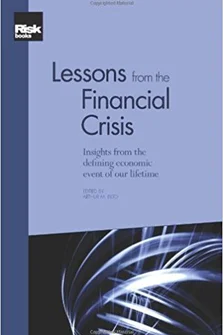Measuring and Managing Risk in Innovative Financial Instruments
Introduction to 'Lessons from the Financial Crisis'
The Credit Crunch of 2007: What Went Wrong? Why? What Lessons Can be Learned?
Underwriting versus Economy: A New Approach to Decomposing Mortgage Losses
The Shadow Banking System and Hyman Minsky’s Economic Journey
The Collapse of the Icelandic Banking System
The Quant Crunch Experience and the Future of Quantitative Investing
No Margin for Error: The Impact of the Credit Crisis on Derivatives Markets
The Re-Emergence of Distressed Exchanges in Corporate Restructurings
Modelling Systemic and Sovereign Risks
Measuring and Managing Risk in Innovative Financial Instruments
Forecasting Extreme Risk of Equity Portfolios with Fundamental Factors
Limits of Implied Credit Correlation Metrics Before and During the Crisis
Another view on the pricing of MBSs, CMOs and CDOs of ABS
Pricing of Credit Derivatives with and without Counterparty and Collateral Adjustments
A Practical Guide to Monte Carlo CVA
The Endogenous Dynamics of Markets: Price Impact, Feedback Loops and Instabilities
Market Panics: Correlation Dynamics, Dispersion and Tails
Financial Complexity and Systemic Stability in Trading Markets
The Martingale Theory of Bubbles: Implications for the Valuation of Derivatives and Detecting Bubbles
Managing through a Crisis: Practical Insights and Lessons Learned for Quantitatively Managed Equity Portfolios
Active Risk Management: A Credit Investor’s Perspective
Investment Strategy Returns: Volatility, Asymmetry, Fat Tails and the Nature of Alpha
In the 2007–9 credit crisis, the issues of improper valuation and inadequate risk management in the use of credit derivatives were at the centre of the credit market turmoil. There has been much discussion about the use of such instruments as mortgage-backed securities, collateralised debt obligations (CDOs) and credit default swaps (CDSs). The crisis has raised the question of how we measure the risks of innovative financial products and manage those risks. Innovative financial instruments are typically illiquid and pose several challenges for their valuation and the measurement and management of the risks associated with them. Measuring risk at some specified time horizon requires the ability to price different assets in future states and to compute different risk measures. Managing risk requires the means to alter a risk profile, through either contractual mechanisms such as master agreements or institutions such as clearinghouses or via the use of hedging instruments. This chapter addresses some of the many issues that arise when a new form of financial instrument is introduced.
Innovation in financial instruments takes two forms: variations on existing types of instruments
Copyright Infopro Digital Limited. All rights reserved.
As outlined in our terms and conditions, https://www.infopro-digital.com/terms-and-conditions/subscriptions/ (point 2.4), printing is limited to a single copy.
If you would like to purchase additional rights please email info@risk.net
Copyright Infopro Digital Limited. All rights reserved.
You may share this content using our article tools. As outlined in our terms and conditions, https://www.infopro-digital.com/terms-and-conditions/subscriptions/ (clause 2.4), an Authorised User may only make one copy of the materials for their own personal use. You must also comply with the restrictions in clause 2.5.
If you would like to purchase additional rights please email info@risk.net











